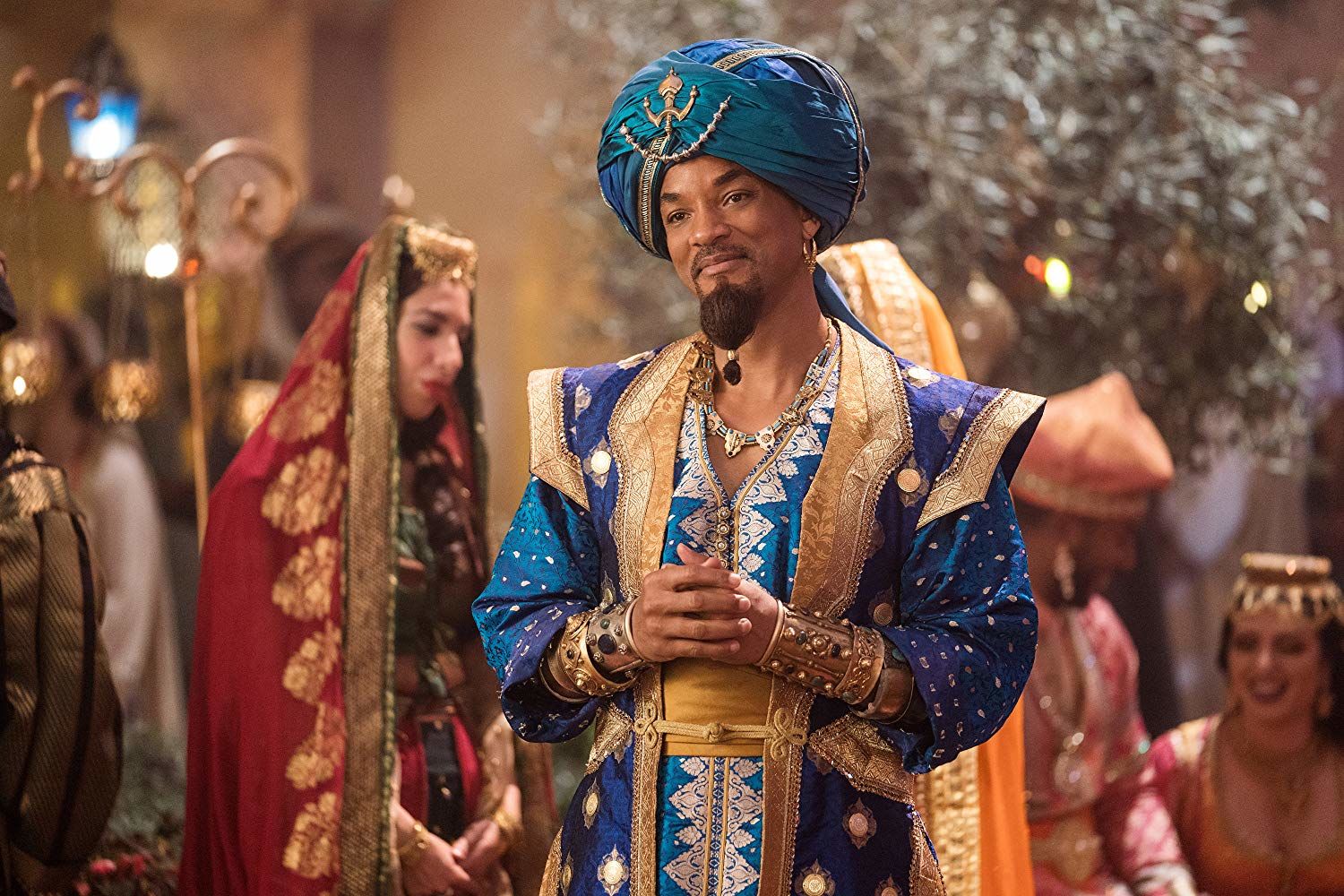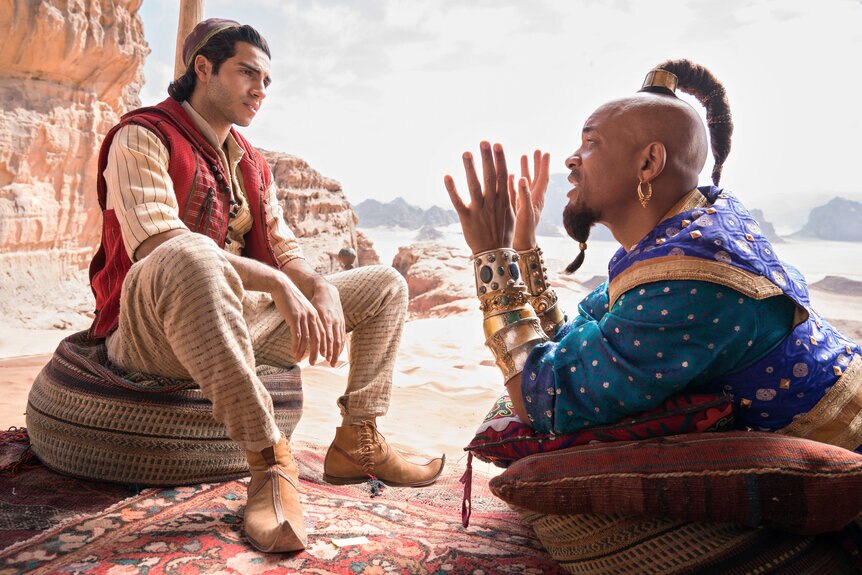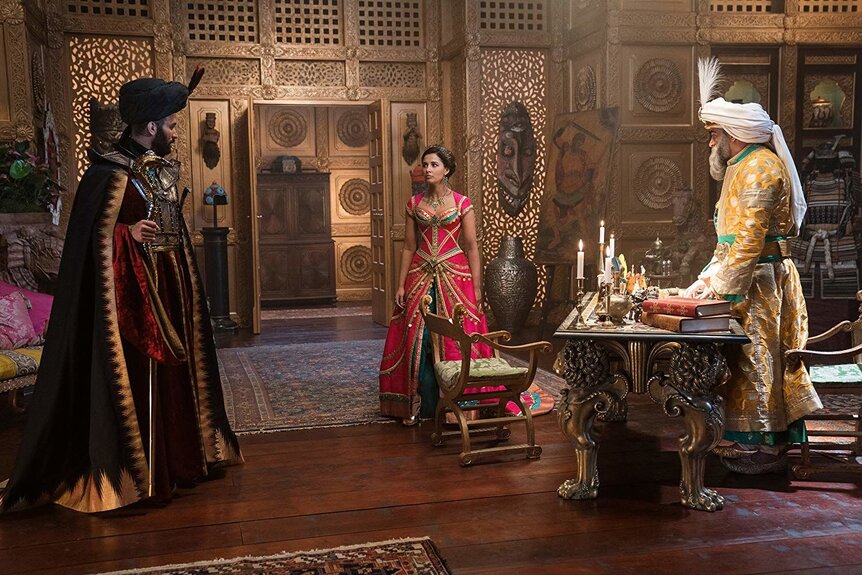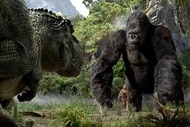Create a free profile to get unlimited access to exclusive videos, sweepstakes, and more!
How Disney updated Aladdin, Jasmine, and the Genie for the 21st century

No one expected the internet's violent reaction to the Genie, least of all the creatives who'd spent almost two years making Will Smith look like, well, that for Disney's live-action Aladdin remake. There everyone was, going about their day, when a first-look trailer revealed a beefed-up, blue Smith sporting an enormous grin, pointed ears, and a topknot.
The memes were instantaneous.
"If I'm completely honest, I think, actually, the [first] shot we showed wasn't the best — a torso shot where you couldn't see his tail and he wasn't doing anything particularly magical or interesting, he was just talking, and he looked like just blue Will," Aladdin VFX Supervisor Chas Jarrett tells SYFY WIRE.
Despite the initial hubbub, when the Guy Ritchie-directed Aladdin remake premiered a few months later, in May, critics and audiences alike would go on to praise Smith's performance as Disney's latest live-action venture raked in the cash ($1.04 billion worldwide, to be exact).
Unlike some of Disney's other live-action remakes (The Lion King, most significantly), Aladdin strays just enough from the initial 1992 animated version audiences know that it manages to surprise at some turns because its creators were so determined to modernize the story. Smith's impish Genie, iconically first voiced by Robin Williams, is updated (and raps a majority of his songs); Princess Jasmine has purpose; and the fantastical Agrabah has realistic depth and texture like never before.
When asked about the initial reaction to the Genie now that Aladdin has proven a box-office success, producer Dan Lin laughs and calls the first response "brutal."
"It's really hard to see, first of all — to see Will Smith or anyone blue, and it's hard to see them all beefed up and larger than life ... so we knew the fans were going to have a reaction," Lin adds. "We didn't know it would be that negative as it was on social media, but I feel like once people saw the movie and saw it in context — because the context was so important — that they would understand why we made the choice we did."
That choice, it turns out, was to add as much realism to a story about literal magic and wishes coming true as possible.
"Guy, I suppose, was very clear that he wanted to ground the film in something a bit more natural," Jarrett explains. That meant as many realistic details as possible, including animals that actually behaved like animals rather than an anthropomorphized monkey (Abu) and parrot (Iago). Still, the Genie was the biggest challenge for Jarrett and his team, who initially imagined a much more caricatured version, even in live-action form — because how do you realistically render a character known for bopping about and changing his physical appearance on a dime?
"Genie was probably the single biggest question," Jarrett says. "[In the beginning], Will Smith hadn't joined yet and we were very much trying to understand how the Genie would work as a live-action creation rather than a drawn, animated one. And, honestly, it became very clear as soon as we hired Will, because when Will Smith comes at you being Will, that's what you want to get on the screen.
"You want to get as much 'Willness' into the character as you possibly can, so I think that clearly steered us away in some ways from being too much of a caricature and sort of led us into leaning into the 'Willism' of Will and his sort of natural performance as the bedrock of the Genie's character."
Lin explains that while Robin Williams' initial take on the Genie was obviously beloved, the last thing they wanted to do was create a carbon copy for the remake.
"The writers really wrote the shape of the character arc and then Will came in with his own personality," Lin explains. "So we would always shoot a version that the writers wrote and Will would do a version that he interpreted as well with his own humor and his own style to it." This distinctive style resulted in what's been referred to as the "hip-hop" Genie — a little bit of Smith's smooth-talking character from Hitch, a little bit of his iconic turn in The Fresh Prince of Bel-Air, but all, undeniably, Will Smith.
Then there's Jasmine. More often than not, Disney princesses are relegated to the sidelines as their suitors do battle either for them or on their behalf. Naomi Scott's Jasmine, however, wants to be Sultan and is willing to fight for it in order to help the people of Agrabah.
"We wanted to update our version of a modern Disney princess and give her real motivation to be a leader," Lin explains. "In our movie, she's being kept out by Jafar and his henchmen and, frankly, even a little bit by her father ... she really sees that Agrabah needs change, and she really wants to be the leader and is held back and then fights through it all."
With Aladdin's help, Jasmine is able to overcome both Jafar's scheme and her father's own prejudice and fear to become Sultan. She also has a solo song (and reprise) and gets the boy.
Beyond updating Jasmine and the Genie, there was everything else.
"We wanted to stick with just the cultural authenticity as much as we could of the original movie. Obviously, some things needed to be updated for today, but we wanted a big event movie that was as diverse and inclusive as possible," Lin says. "We talked about the empowerment of Jasmine, [and] there's some jokes or comments that didn't feel ethnically [like] where we wanted to go with this movie."
Indeed, in the 2019 version of Aladdin, lyrics are changed — the opening song "Arabian Nights" refers to Agrabah as "chaotic" rather than "barbaric," and no one sings about the slaves who love serving "Prince Ali" — and details are added to make the movie as inclusive as possible. The scale is enormous, the film's design influences spanning countries and regions alike. There are accusations that the movie paints with too broad a cultural brush, but the creative team insists that the work they put in was for the sake of inclusivity rather than implying interchangeability.
For production designer Gemma Jackson, adding so many specific culture details was important because she wanted to imply Agrabah is "right in the middle of an extraordinary part of the world."
One thing they avoided, though, according to Jackson, was anything that held too much religious context. "We just absolutely didn't want to go there," she says. "I think it was a really sensible decision, so we just created this rather wonderful world but with a big chunk missing called religion, which would be the scourge of the world anyway. I mean, most wars are about religion, aren't they? And that wasn't a war that we wanted to start."
Jackson points out the various details she's most proud of: the Byzantine style of the palace, which is decorated in deference to wooden monasteries she once saw in Myanmar; some shutters and railings that were manufactured in Morocco; the painted panels on some of the boats, which she bought in a market in Myanmar; the Turkish pottery in Aladdin and Jasmine's bedrooms.
"It's just colorful and poignant to me, and the textures are gorgeous," Jackson explains. "I just feel it was the right sort of language for Aladdin."
Aladdin will be released on digital on August 27 and Blu-ray on September 10.




























